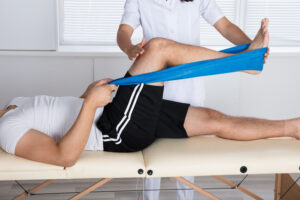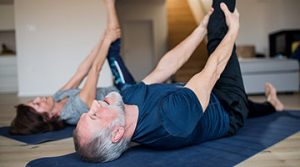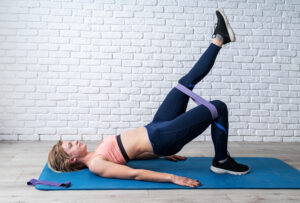What are the best exercises to help with lower back pain?

Lower Back Pain
Chronic lower back pain is a very common thing to suffer from, in fact, it is the most common non-communicable disease on the planet and is the single largest contributor to disability (1). As you might imagine with something so common that causes such an impact on people’s ability to live a full life there has been an enormous amount of research into which treatments may work best. One of the most consistent findings of the research is that exercise is very helpful, in fact beginning a routine of exercise is one of the most impactful things you can do to help reduce or prevent chronic lower back pain (2). This begs the question which type of exercise is best. Is there a specific activity or an exercise routine that will reliably reduce or stop my back pain from occurring?
What Exercise Helps With Chronic Lower Back Pain?
 Basically, nearly everything. This is even more true if you are experiencing chronic low back pain and you currently take little or no exercise. The most common piece of beneficial advice that can be given to help with chronic low back pain is to BE ACTIVE (3)! Getting more active may be as simple as taking a short walk or gently swimming within reasonable pain limits. There are however some types of exercise that seem to be better than others.
Basically, nearly everything. This is even more true if you are experiencing chronic low back pain and you currently take little or no exercise. The most common piece of beneficial advice that can be given to help with chronic low back pain is to BE ACTIVE (3)! Getting more active may be as simple as taking a short walk or gently swimming within reasonable pain limits. There are however some types of exercise that seem to be better than others.
Yoga
Yoga has been shown to be of benefit in the treatment of chronic low back pain when compared to usual care (which would include activity advice) (4). There did not appear to be much difference between whether the yoga was ‘back focused’ or more generalised (5). When compared to other forms of exercise and hands-on treatment the benefit of yoga was not significant meaning yoga may be better used as an addition to other therapies and exercises (6).
Core/trunk stability and strength training
These exercises would be described as being a combination of exercises that are performed with the aim of strengthening the various muscles that support the spine during movement, usually performed on a stability device like an exercise ball. Performing this type of exercise has been shown to be better than generalised exercise in the short term but not better over a longer period of time (7).
Motor control exercises
These exercises are more concerned with the deeper stabilising systems of the spine, muscles like the transverse abdominus, the diaphragm, and pelvic floor muscles. These muscles have been shown to be less active in people who have lower back pain (8). This type of exercise has been shown to be more effective in the treatment of low back pain than general exercise and spinal manipulation in the short and long term (9, 10). These exercises are more to do with muscle activation and control and can be hard to become proficient in. You can find some examples of stabilisation exercises for lower back pain in this video.
Pilates
 There is inconsistent evidence that Pilates style of exercise can be beneficial to sufferers of chronic lower back pain. It has been shown that Pilates is more beneficial than minimal intervention but not any more so than other types of exercise (6). The NHS feels confident enough that it may help that they have produced a video of Pilates exercises for chronic low back pain.
There is inconsistent evidence that Pilates style of exercise can be beneficial to sufferers of chronic lower back pain. It has been shown that Pilates is more beneficial than minimal intervention but not any more so than other types of exercise (6). The NHS feels confident enough that it may help that they have produced a video of Pilates exercises for chronic low back pain.
Aerobic Exercise
Aerobic exercise has been shown to help with lower back pain (11), and a low level of aerobic fitness is associated with chronic lower back pain (12). Gentle aerobic exercise, such as walking or swimming can improve the blood flow to the muscles in the back with may be contributing to the pain while not producing a load on the back that would cause pain, and performing 30-40 minutes of this type of exercise can lead to the release of endorphins which also help reduce pain (13). Several studies have shown that moderate-intensity aerobic exercise can help with reducing lower back pain by nearly 50% when combined with other treatments (11). The NHS explains moderate exercise as ‘an activity that will raise your heart rate, and make you breathe faster and feel warmer. One way to tell if you’re working at a moderate intensity level is if you can still talk, but not sing’.
Posterior Chain Exercises
The posterior chain can be described as the muscles generally on the back of the body that are used mostly to help you stand up straight, stand up from a bent forward position, and to draw your shoulders back. Exercises such as deadlifts, back extensions, and shoulder rows would be mainly working the posterior chain. One study showed that exercises that target the posterior chain show more improvements in pain levels and disability when compared to general exercises such as walking. They also observed that the exercises were well tolerated with no extra reports of pain when compared to the general exercise group (14).
Which Type of Exercise is Best?
As mentioned earlier, exercise is one of the most commonly recommended interventions to help with chronic low back pain, it is recommended in three of the most recent guidelines (15, 16, 17).
A more recent review found that the modalities of Pilates, motor control exercises, and aerobic exercise were the most likely to reduce pain, while Pilates and motor control exercises were most likely to improve physical functioning. This review also found that interventions that use a ‘hands-off’ approach such as GP management, advice, and psychological interventions were least likely to be effective (18).
What is our recommendation to sufferers of lower back pain?
 If your pain has a relatively recent onset and has been quite acute then get help from an osteopath, osteopaths deal with these types of problems on a daily basis and there is good evidence that osteopathic techniques, in general, can reduce back pain and speed recovery (19). If your pain is more chronic (over three months) what you should NOT do is nothing. As outlined by the evidence above doing some activity is much more likely to help with your pain levels than doing none. The three choices of exercise that are most likely to help, Pilates, motor control exercises, and aerobic exercise may not be suitable for everyone, the choice of which exercise modality should be made considering the reason for your pain, what your treatment goals are, and which type of exercise you are most likely to enjoy (so you do it regularly). Other factors such as accessibility to equipment (gym, swimming pool, etc.) may also play a part.
If your pain has a relatively recent onset and has been quite acute then get help from an osteopath, osteopaths deal with these types of problems on a daily basis and there is good evidence that osteopathic techniques, in general, can reduce back pain and speed recovery (19). If your pain is more chronic (over three months) what you should NOT do is nothing. As outlined by the evidence above doing some activity is much more likely to help with your pain levels than doing none. The three choices of exercise that are most likely to help, Pilates, motor control exercises, and aerobic exercise may not be suitable for everyone, the choice of which exercise modality should be made considering the reason for your pain, what your treatment goals are, and which type of exercise you are most likely to enjoy (so you do it regularly). Other factors such as accessibility to equipment (gym, swimming pool, etc.) may also play a part.
At Align Body Clinic we have helped hundreds of people with chronic low back pain understand the reason for their pain, then by using a series of clinical tests can prescribe stability exercises and aerobic exercise advice in line with the evidence presented above that will help get you out of pain and get back to living a full life.
If you want to see the types of exercises we recommend for various conditions you can visit our resources page.
Do you want to know what is causing your pain and if we can help? Why not take advantage of our new patient assessment introductory offer to get you started towards a tailor made recovery plan for only £19.
Are you in a lot of pain and want to get better as soon as possible? If so then why not book in for a new patient consultation, with treatment on the day, for £75.
References
1 –Vos T , Flaxman AD , Naghavi M , et al . Years lived with disability (YLDs) for 1160 sequelae of 289 diseases and injuries 1990–2010: a systematic analysis for the global burden of disease study 2010. The Lancet 2012;380:2163–96
2 – Searle A , Spink M , Ho A , et al . Exercise interventions for the treatment of chronic low back pain: a systematic review and meta-analysis of randomised controlled trials. Clin Rehabil 2015;29:1155–67.
3 – Delitto A, George SZ, Van Dillen L, Whitman JM, Sowa G, Shekelle P, et al. Low Back Pain: Clinical Practice Guidelines Linked to the International Classification of Functioning, Disability, and Health from the Orthopaedic Section of the American Physical Therapy Association. J Orthop Sports Phys Ther. 2012;42(4):A1-A57.
4 – Holtzman S, Beggs RT. Yoga for chronic low back pain: a meta-analysis of randomized controlled trials. Pain Research and Management. 2013 Oct;18(5):267-72.
5 – Wieland, L.S., Skoetz, N., Pilkington, K., Vempati, R., D’Adamo, C.R. and Berman, B.M., 2017. Yoga treatment for chronic non‐specific low back pain. The Cochrane Library.
6 – Jacobson, B., Westcott, T., Bohanan, A., Lopez A. Chronic Low Back Pain – Available at – https://www.physio-pedia.com/Chronic_Low_Back_Pain
7 – Luciana G Macedo, Christopher G Maher, Jane Latimer, James H McAuley, Motor Control Exercise for Persistent, Nonspecific Low Back Pain: A Systematic Review, Physical Therapy, Volume 89, Issue 1, 1 January 2009, Pages 9–25, https://doi.org/10.2522/ptj.20080103.
8 – Inani S.B., Selkar S.P. Effect of core stabilization exercises versus conventional exercises on pain and functional status in patients with non-specific low back pain: A randomized clinical trial. J. Back Musculoskelet. Rehabil. 2013;26:37–43.
9 – Macedo LG, Maher CG, Latimer J, McAuley JH. Motor control exercise for persistent, nonspecific low back pain: a systematic review. Physical therapy. 2009 Jan 1;89(1):9-25.
10 – Ferreira ML, Ferreira PH, Latimer J, Herbert RD, Hodges PW, Jennings MD, Maher CG, Refshuage KM. Comparison of General Exercise, Motor Control Exercise and Spinal Manipulative Therapy for Chronic Low Back Pain: A Randomized Trial. Pain. 2007;131:31-37
11 – Gordon R, Bloxham S. A Systematic Review of the Effects of Exercise and Physical Activity on Non-Specific Chronic Low Back Pain. Healthcare (Basel). 2016 Apr 25;4(2):22. doi: 10.3390/healthcare4020022.
12 – Duque I.L., Parra J.H., Duvallet A. Aerobic fitness and limiting factors of maximal performance in chronic low back pain patients. J. Back Musculoskelet. Rehabil. 2009;22:113–119.
13 – Kenny W.L., Wilmore J.H., Costill D.L. Physiology of Sport and Exercise. 5th ed. Human Kinetics; Champaign, IL, USA: 2012.
14 – Tataryn, N., Simas, V., Catterall, T. et al. Posterior-Chain Resistance Training Compared to General Exercise and Walking Programmes for the Treatment of Chronic Low Back Pain in the General Population: A Systematic Review and Meta-Analysis. Sports Med – Open 7, 17 (2021). https://doi.org/10.1186/s40798-021-00306.
15 – UK NG. Low back pain and sciatica in over 16s: assessment and management.
16 – Van Wambeke P, Desomer A, Ailiet L, Berquin A, Dumoulin C, Depreitere B, Dewachter J, Dolphens M, Forget P, Fraselle V, Hans G. Low back pain and radicular pain: assessment and management. KCE Report. 2017;287.
17 – Qaseem A, Wilt TJ, McLean RM, Forciea MA. Noninvasive treatments for acute, subacute, and chronic low back pain: a clinical practice guideline from the American College of Physicians. Annals of internal medicine. 2017 Apr 4;166(7):514-30.
18 – Qaseem A, Wilt TJ, McLean RM, Forciea MA. Noninvasive treatments for acute, subacute, and chronic low back pain: a clinical practice guideline from the American College of Physicians. Annals of internal medicine. 2017 Apr 4;166(7):514-30.
19 – Licciardone et al (2006). Osteopathic manipulative treatment for low back pain: a systematic review and meta-analysis of randomized controlled trials. BMC Musculoskelet Disord. 2005; 6: 43. Available at, http://www.ncbi.nlm.nih.gov/pmc/articles/PMC1208896/.



